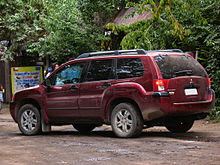Mitsubishi Endeavor
| Mitsubishi | |
|---|---|
|
Mitsubishi Endeavor (2003-2006)
|
|
| Endeavor | |
| Production period: | 2003-2011 |
| Class : | SUV |
| Body versions : | Station wagon |
| Engines: |
Petrol engines : 3.8 liters (160–168 kW) |
| Length: | 4831-4846 mm |
| Width: | 1869 mm |
| Height: | 1760-1783 mm |
| Wheelbase : | 2751 mm |
| Empty weight : | 1755-1890 kg |
| Previous model | Mitsubishi Challenger I. |
| successor | Mitsubishi Challenger II |
The Mitsubishi Endeavor is a sport utility vehicle from the Japanese car manufacturer Mitsubishi Motors, which was built in Normal (Illinois) exclusively for North America from spring 2003 to summer 2011 .
The Endeavor was launched as the successor to the Mitsubishi Challenger for the 2004 model year. It was the first model of Mitsubishi's "Project America", which is dedicated to vehicles that have been specially developed for the North American market. In the manufacturer's model range, the Endeavor is positioned above the Outlander and competed with models such as the Honda Pilot or the Toyota Highlander .
design
The Endeavor , first presented in January 2003 at the North American International Auto Show in Detroit, was designed by David O'Connell's design team. Particularly characteristic are the widely exposed wheel arches and the associated lateral body extensions in the door area. The front is characterized by a radiator grille divided by the Mitsubishi emblem with horizontal slats and straight, large headlights. At the rear there is a rear window that can be opened separately and is convexly curved downwards, as well as very narrow and far outside rear headlights. The latter are widened towards the center by triangular reflectors. An unusual design feature for SUVs are the free-standing exterior mirrors, which are painted black or in the same color as the vehicle, depending on the model. The interior of the five-seater Endeavor is similar to that of the American Mitsubishi Galant , except for the wide, T-shaped center console .
Furnishing
The standard equipment LS initially comprised an air conditioning system, a CD radio, 17-inch wheels, a cruise control system as well as electric windows and exterior mirrors. In the higher-quality versions XLS and Limited , an alarm system, automatic air conditioning, heated leather seats and a CD changer were added. In the 2004 model year, the safety equipment included traction control, ABS as well as driver and passenger airbags, side airbags only from XLS . During the construction period, the latter as well as head airbags and ESP were installed as standard in all models.
technology
Based on Mitsubishi's PS platform, which is also used by the Galant, the Eclipse and the 380 , a front-wheel drive floor assembly was created that could only be combined with all-wheel drive as an option on the Endeavor . The only engine available was a 3.8-liter V6 petrol engine in conjunction with a 4- speed automatic transmission . This motor, known internally as 6G75 , was also used in the other models of the PS platform and the Pajero . In the Endeavor it initially had 160 kW and was increased to 168 kW in the 2005 model year.
| 3.8 liter V6 | 3.8 liter V6 | |
|---|---|---|
| Construction period: | 2003-2004 | 2004-2011 |
| Engine type: | Six-cylinder gasoline engine in V-type | |
| Displacement: | 3828 cc | |
| Max. Performance in min -1 : | 160 kW (218 PS) / 5000 | 168 kW (228 PS) / 5000 |
| Max. Torque at min -1 : | 339 Nm / 3750 | 346 Nm / 3750 |
| Gearbox, as standard: | 4-speed automatic transmission | |
|
Drive, as standard [drive, optional]: |
Front-wheel drive [all-wheel drive] |
|
| Acceleration, 0-100 km / h: | 9.0 s | 9.1 s |
| Top speed: | 195 km / h | |
|
Fuel consumption (combined over 100 km): |
13.5 L Super (17.5 mpg (US) ) | |
| CO 2 emissions, combined: | 313 g / km | |
Model maintenance
2006
At the beginning of 2006 the Endeavor was slightly revised. Above all, the narrower and, depending on the model, chrome-covered radiator grille with two instead of four slats and a new front bumper with larger fog lights and indicated underride protection characterize the facelifted version. At the rear there is meanwhile a deeper rear apron, also with indicated underride protection. Only minor improvements were made to the interior.
2009
In summer 2009 there was another facelift. At the front, it mainly affected the radiator grille, which now no longer had a vertical division and does not have any slats.
The biggest innovations took place at the rear: there was a modified tailgate with a new rear window and a chrome-plated trim. In addition, the rear lights have been widened and the function of opening the rear window separately has been omitted. Detailed changes in the interior related, for example, to a new control unit for the ventilation and air conditioning system. The extended standard equipment of the equipment lines now known as LS (basic) and SE (higher-quality version) included fog lights, a tire pressure monitoring system, a Bluetooth hands-free system and bumpers, exterior mirrors and door handles painted in body color. For the first time, there were also 18-inch alloy wheels for the SE version.
Production ended in August 2011 and the Mitsubishi Challenger II took over in some markets.
swell
- Auto-News online edition of January 17th, 2003: "Mitsubishi presents the Endeavor for the first time in Detroit"
- Autoweek online magazine from April 25, 2011: "Mitsubishi stops production of 3 models in North America"



